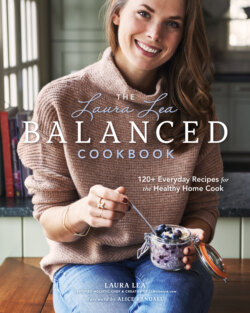Читать книгу The Laura Lea Balanced Cookbook - Laura Lea - Страница 35
На сайте Литреса книга снята с продажи.
ОглавлениеFATS
• Extra-virgin olive oil: As classic as it gets;
I probably use olive oil every single day in
cooking. Its slightly savory umami flavor
pairs with almost any protein or vegetable,
and it is full of heart-healthy fats. When
it comes to olive oil, make sure you are
purchasing “extra-virgin first cold-pressed”
oil, and look for a bottle that is dark/opaque
(to protect it from destabilizing sunlight
heat). This ensures you are getting the
freshest, highest quality olive oil, which
easily goes rancid.
• Extra-virgin organic coconut oil*
• Grass-fed butter: What is left to be said
about butter? It makes everything taste
better, richer, more satisfying, and more
complex. I use it in moderation, as I do
all ingredients, but there are certain
instances in which nothing beats butter—
like slathered on a freshly baked muffin
or tossed in pasta with a pinch of sea salt.
I always have Kerrygold grass-fed butter
in my fridge, and unless you have a dairy
allergy or intolerance, I recommend the
same for you.
• Toasted sesame oil*
VINEGARS
• White balsamic vinegar: This is my go-
to vinegar, and my husband actually
introduced me to it. Made from white grapes
and white wine vinegar, white balsamic has
a lovely flavor and a clean aftertaste. It also
has a hint of sweetness, and I think it is an
ideal base for salad dressings. If you want
a vinegar that is less intense than white
vinegar, I highly recommend this.
note: When a recipe calls for this in the
book, it is factoring in the natural sweetness
of white balsamic. If you substitute a more
acidic/less sweet vinegar, you should add
more sweetener to taste.
• Dark balsamic vinegar: A classic and staple
of our pantry. Good balsamic vinegar is
made from simmering grapes for hours
until they are syrupy and caramelized.
Dark balsamic has a rich flavor that is ideal
for adding complexity and acid to cooked
dishes. To concentrate the flavor even more,
you can purchase reduced balsamic vinegar
or reduce it yourself: simply add it to a sauce
pan and simmer until it reaches a syrupy
consistency. This is a dream drizzled on
fresh tomatoes in the summer.
• Apple cider vinegar (ACV): The most acidic
of these three, apple cider vinegar is made
from fermented apples. Used for centuries
in home and health-care applications, apple
cider vinegar has numerous purported
health benefits, such as improving digestion,
whitening teeth, and regulating blood sugar.
Raw, unfiltered ACV contains “the mother,”
a cobweb-looking substance made from
proteins, enzymes, and beneficial probiotic
organisms. While I do not find apple cider
vinegar to be the “cure all” that some have
touted, I do find that it can help settle a
stomach ache (I use 2 teaspoons in 1 cup
of filtered water). Primarily, I use ACV for
its astringent but neutral flavor when I
want a nice hit of acid in a sauce or even a
baked good recipe. I encourage you to do
some ACV research on your own if you are
interested in the health benefits.
